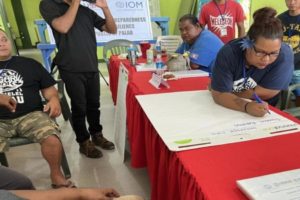IOM supports Palau to build community resilience and preparedness to natural hazards

The Republic of Palau is exposed to natural hazards such as storm surges, typhoons, earthquakes, and tsunamis that can result in localized and national emergencies as well as population displacement.
The International Organization for Migration (IOM), in partnership with the National Emergency Management Office (NEMO), has been working closely with the Government of the Republic of Palau (Palau) and community members to prepare for, and respond in a timely manner to, lifesaving needs during natural hazards and shocks.
IOM, under the Palau Emergency Preparedness and Enhanced Resilience project, funded by the United States Agency for International Development’s Bureau of Humanitarian Assistance, engaged the Government of the Republic of Palau, NEMO, Palau Red Cross Society, Ministry of Education, and community members in tabletop exercises to test emergency response plans and procedures and address operational gaps by working closely with relevant authorities.
"Employing a comprehensive approach to disaster risk management requires the contribution and engagement of various government actors as well as community group representatives at all stages of the preparedness, response and recovery process," says Salvatore Sortino, Chief of Mission to IOM Federated States of Micronesia, Republic of the Marshall Islands, and Republic of Palau.
"Tabletop exercises like these are key to ensuring comprehensive understanding and full ownership of respective roles and responsibilities. We are extremely grateful to NEMO for their leadership in these exercises," Sortino added.
IOM together with key government and non-government representatives reviewed Early Warning Processes to improve early warning systems, underlining roles and responsibilities of stakeholders in the event of a natural hazard.
In Melekeok State, where tsunami preparedness systems need strengthening, IOM conducted a tabletop exercise to simulate hazard events and enable coordination on effective use of emergency communication channels, emergency evacuation routes, and school evacuation procedures among other critical aspects of tsunami response.
These tabletop exercises complement ongoing efforts to address critical needs by improving evacuation shelters and their management to minimize injury and loss of life, as well as testing government response structures and pre-positioning relief items.
IOM revamped five emergency evacuation shelters (EES) including the installation of typhoon shutters, and provision of water tanks, generators, and solar lights.
Additionally, through the project, more than 80 community representatives in five states have been trained on EES management, and five water quality management teams have been established and trained.

